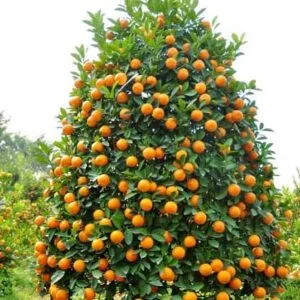No products in the cart.
Table of Contents
Dendrobium orchids will bring color to your boring home when it looks dull. So, why not add the Dendrobium genus to your collection today?
Dendrobium Orchids are divided into the Dendrobium Nobile’ Soft Cane’ species and the Dendrobium Phalaenopsis’ Hard Cane’ plant.
While they have loads in common, both inhabit nature differently, so their care differs. But they both share their profuse blooms in different pastel tones.
Plantly will provide you with the Dendrobium Orchid care for both these plants (Yeah.) So you will not need to browse to find out what works best for your species.
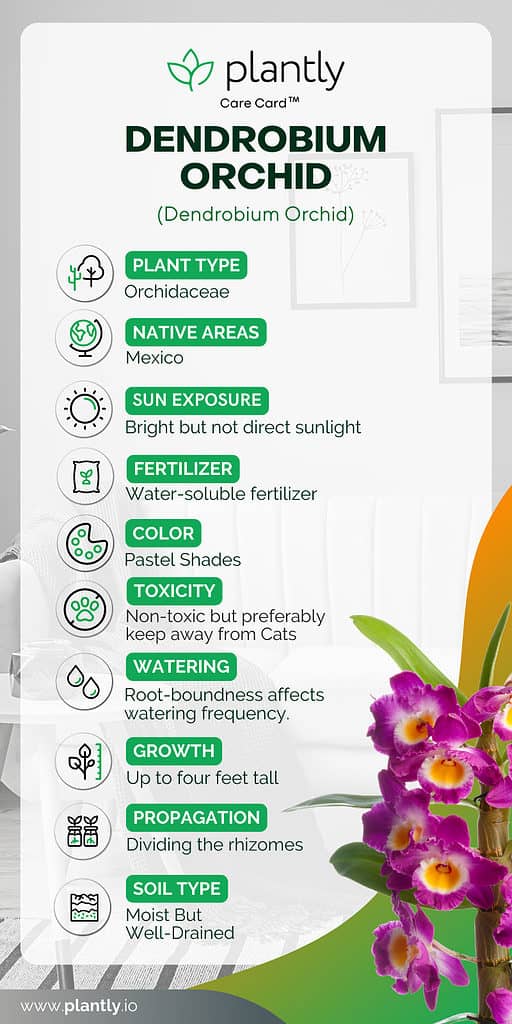
The Difference in The Dendrobium Genus
The Dendrobium plant is a diverse species of Orchids, each with its own cultural needs. However, as mentioned, you get two types: the Dendrobium Phalaenopsis and Dendrobium Nobile. These orchid species are native to southeast Asia and thrive in this growing environment.
The Dendrobium Phalaenopsis, or Hard-caned species, has a tall, thin pseudobulb with darker leaves and is an evergreen plant. It keeps its leaves for years before dropping them. The plant grows spikes from the top, producing beautiful flower sprays.
Furthermore, the plant loves a bright environment. On the other hand, the soft cane is well known for its attractive flower. The Dendrobium Nobile flower grows from the canes with thin leaves, and tiny buds appear on each node at the end of Winter.
Care for this tropical plant is not always easy indoors, but it is possible. Compared to the Hard-cane, the Soft-cane flowers are better in cool winter temperatures.
Dendrobium Orchid Care
The Dendrobium is a large genus, and you can find hundreds of species. Still, as with most orchids, these beautiful flowers need good air circulation in warm conditions during the growing season. When you grow Dendrobium orchids and want them to rebloom, it is promoted with a winter rest period.
You can provide the Dendrobium nobile and Dendrobium spatula with lower temperatures and withhold water for up to four weeks. Still, some orchid species in the genus only have a single rebloom, and others can rebloom up to five times a year.
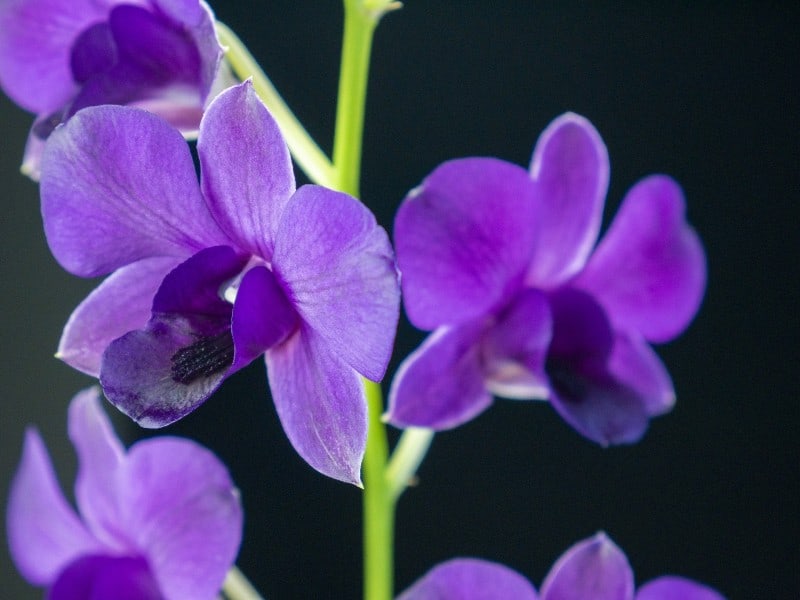
This gorgeous ornamental houseplant will thrive mainly if kept as an indoor plant, but if you want to treat it as an outdoor plant, make sure it’s in a place with shade or surrounding trees near it.
Great, now we have the differences between the Dendrobium Orchids (Shoe.) So, to help with the care requirements, we will refer to the Hard-Cane and Soft-Cane for each one’s requirements.
Lighting
Okay, the hard cane enjoys bright but not direct sun. So keep it bright, bright. You can place them at east or west-facing windows where the morning sun gently shines on them. Ensure they get dappled light behind a sheer curtain for the south windows.
Now, if you live in an area where the days grow shorter than ten hours, maximize the length of light. So, no direct light as your tropical plant will die. Instead, we recommend keeping your eye on the sun throughout the year and moving your Dendrobium Orchids accordingly.
Great, now the strange thing is your Soft-cane tolerates more light and enjoys bright light in summer and direct sunlight in Winter. But limit the exposure to light in sunlight to only a few hours in the morning and afternoon. Then, you can place it at a south-facing window during spring, fall, and Winter.
Yet, move them to an east-facing window in summer to prevent leaf scorching during the active growing season.
Temperature and Humidity

Now, if there is one thing both Dendrobium Orchids have in common, it is the temperature. Both do well in daytime temperatures between 65 to 85 degrees Fahrenheit.
But Dendrobium orchids live there best, with nighttime cooler temperatures not dropping below 54 degrees Fahrenheit. That is good news, but keep specific temperatures for your soft cane in autumn.
The reason is that it helps stimulate bud and bloom growth. The humidity level demand is almost the same; the Hard-cane can be between 50% to 60%, while the soft cane thrives at humidity levels of 50% to 70%.
Invest in a humidifier at home or a humidity tray to increase high humidity levels indoors if necessary.
Air Circulation
Whether you have Hard-cane or Soft-cane Dendrobium Orchids, they need sufficient airflow. Do you live in a poorly ventilated living space? We recommend opening a window or using an oscillating fan to reduce the risk of your plant getting a fungal disease.
Now, please do not go and set that fan on high or expose them to cold drafts. It will cause bud drops.
Growing Dendrobium Orchids and Soil
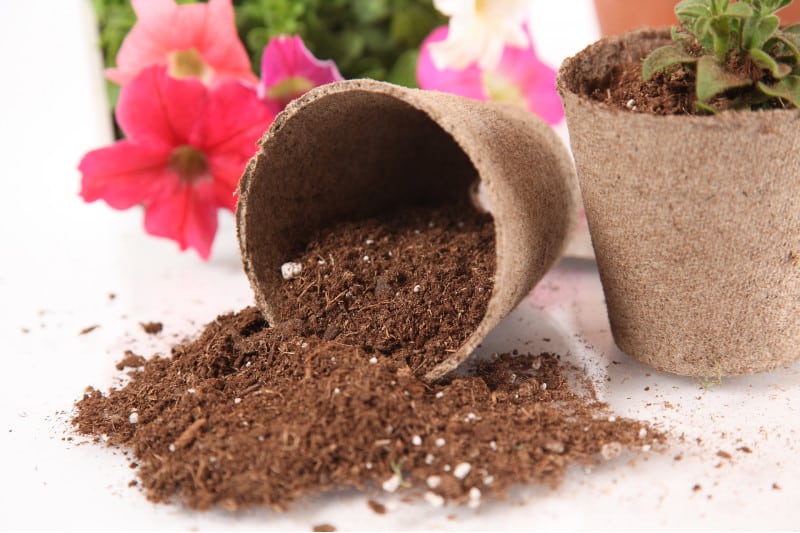
The Dendrobium orchids live in the wild attached to trees, so they do not thrive in your typical growing medium. Instead, they need a unique orchid mix to mimic their environment.
Read Choosing The Right Orchid Growing Material for their Special Needs for more details. So, when re-potting, choose a potting mix of coconut husk, perlite, or fir bark.
Ensure the medium has aeration and is well-draining so the roots aren’t left in too much moisture for a lengthy period. Also, when you re-pot, provide your orchids with clay pots and enough drainage holes.
Dendrobium Watering
The good news is when watering orchids. They enjoy moist soil with drying out between watering. The best way is to use your finger to keep an eye on the moisture level in the soil.
If dry, run the water through to saturate everything and leave it to drain well from the potting medium. Now, a big no-no: do not leave your plant in the water while it loves humidity.
You get a one-way ticket to Root Rot Town and head out to Trash Can City. Frequent watering also depends on how root-bound it is and the size of the pot. Another excellent tip is to water your plants in the morning.
Then, during autumn and Winter, you can slow down the watering. Then, when your Dendrobium plant flower spikes, you can start increasing the water during the blooming season. Preferably, also use distilled water, not tap water, as these plants are sensitive to salt and chlorine.
Fertilizer
You can feed both the Dendrobium Orchids with a water-soluble fertilizer made for the plant using only a few drops. You can do this every two weeks, making it half the recommended strength during the active growth season.
So why do we say this? The Orchid’s roots can quickly burn when you use strong fertilizers. So, if you feed your tropical plant weekly, water your flower every fourth week to flush out the fertilizer from the clay pot.
Another concern to watch out for is a high nitrogen level, which causes excessive green leafy growth, promoting baby plant offshoots (Keikis.) In turn, it will divert the energy to produce less flowers. During October, you can stop feeding as it helps stimulate reblooming.
The same applies to reducing the water and exposing your plant to cooler temperatures where permitted. Also, remember to keep your plants out of direct sunlight and use a balanced fertilizer.
You can, however, resume feeding after the flowering is finished.
Potting

Both your Dendrobium Orchids enjoy being root-bound. Please give us a yeah! So, you only need to re-pot it to a new potting media every two to three years. Only go one size bigger if your orchid species are in small pots. Ensure it also has excellent drainage.
The best time to do this is when the flowering phase is done and enters vegetative growth. Doing this at other times can interrupt the growth, leading to the premature ending of the flowers. Now is the time to provide your plant with fresh potting and add some Orchid fertilizer while also checking the root system.
Potting Mix Tips
Your Dendrobiums are epiphytic, meaning they grow on other plants instead of in the ground. So when potted, it helps ensure the loam is well aerated and provides enough water drainage. Okay, great, but what potting mix should I use with your new pot?
We’ve got you covered here as well. You can use a pre-prepared Orchid mix or make your own.
Use an equal mixture of coarse pine bark
Husk
Perlite
Mixing a fresh potting medium using fir bark or sphagnum moss helps grow Dendrobium plants fast. Furthermore, it provides root mass with nutrients and aeration in the potting media throughout the growing season. The loam is packed with nutrients to create a natural yet airy environment for both plants.
Remember to keep the humidity around your plant at the right level. You can buy a pebble tray at the garden center or a digital temperature monitor showing whether you need to increase humidity.
Propagating Dendrobium Orchids
When it comes to Orchid propagation, you can find different methods to do this, as seen here:
Keikis
When growing in low-light conditions, your Orchid produces offshoots known as Keikis. It grows from buds found on the cane in the upper section. For the Dendrobium Nobile, the Keiki extends along the length of the cane at the end.
The Dendrobium Phalaenopsis Keikis you find on the node along the stem of the flower. You can remove the Keikis to transplant when it has grown new leaves and shoots at least a few inches long. As the root growth starts, you can remove it and place it in a well-draining Orchid potting medium.
Pseudobulbs Technique
The method is done by dividing the rhizomes by severing them between the stem-and-leaf growths found at the mother plant’s base. Use a sterilized knife and sever the bulb from the old one at the axis while cutting close to the older pseudobulb.
If no bulb is present, cut the rhizome into small pieces with at least four eyes available on each section. Place the bulbs or rhizome in moist sphagnum peat moss. Please place them in a low-light environment providing good ventilation. You can mist them twice daily and ensure the sphagnum remains moist, not soggy gardeners.
Once new growth develops, you can move your plants to a pot and natural environment.
Furthermore, you can propagate with orchid seeds, but it is not recommended. The reason is that the orchid seeds need a controlled environment to germinate, which is a lengthy process.
People wait until after it is finished flowering to collect the seed.
Growth Zone

Depending on what USDA hardiness zone you live in, you can leave it outside in Winter for a few weeks after it has flowered, and temperatures as low as 50°F are fine but not below. If you live in USDA zones 9 to 12, you can grow your Dendrobium Orchids easily.
Drying Out of the Canes
While the Nobile Orchid can tolerate a lot of water and is not so susceptible to root rot as the Phalaenopsis Orchids, underwatering it can lead to the canes wilting and drying out. Check the soil surface to see if it is dry during the growing season and wet it.
However, during dormancy in wintertime, you can let the soil dry out. The same applies to the Hard-cane, and keeping an eye on the potting soil is best.
Dendrobium Varieties and Similar Plants
The Dendrobium Orchid species is huge, and here are some of the other varieties you can find:
Dendrobium Phalaenanthe
Also called Den-phals, it has similar moth-shaped flowers found in the Phalaenopsis orchid. The plant is a warm grower enjoying higher light and makes for an excellent beginner gardener.

Dendrobium Spatulata
Spatulata has horn-like projections spiraling into flowers looking like Antelope horns. The plant enjoys hot climates and needs no rest period as they can bloom for several years.
Dendrobium Latouria
These species have hairy lips or a bottom petal where the pollinator lands. The plant is short and stumpy with small rhizomes and comprises pseudobulbs. The plant is more than an epiphyte, as some are terrestrial growing in grasslands.
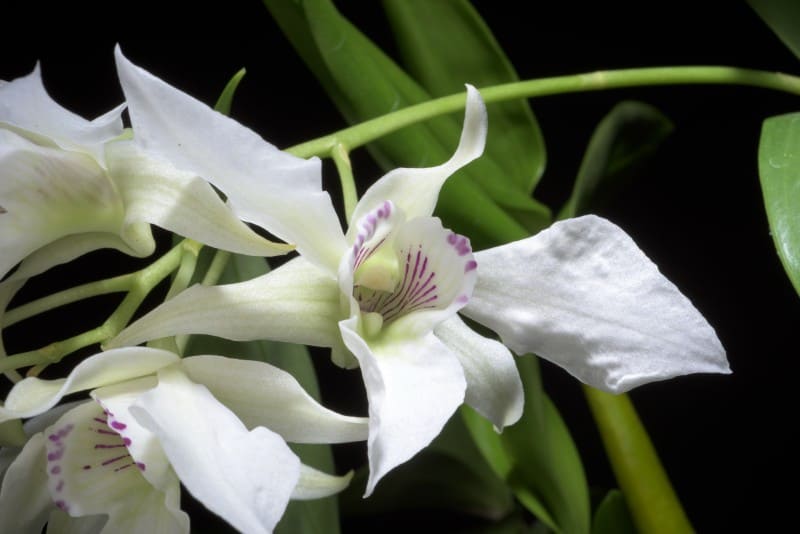
Common Diseases & Pests
Both these Orchid plants are hardy foliage resistant to pests. The most common problem is scale, but they can also be affected by mealybugs, fungus gnats, thrips, whiteflies, and mites.
You can treat these infestations with water and dish soap added to a spray bottle to spray on your plants.
For more details on caring for Dendrobium orchids and pests, read Plant Pest and Pathogens Causes and Treatments. Other problems are yellow leaves that can also occur, especially with the Dendrobium nobile after the flowering phase and normal.
But if you notice yellow on the new growth, there is a problem. It can be from over or underwatering. If the leaf is crunchy, it is underwatering, or too much sun. If not crunchy, check the potting media. If not waterlogged, it can be a sign of root rot.
Another thing that can cause the yellow color is underfeeding; it is best to give it fertilizing to help it recover. When it comes to the Phalaenopsis Orchid, it can be that your plants are getting too much light.
Frequently Asked Questions
When in bloom, the Dendrobium orchid can last up to eight weeks and makes for beautiful cut flowers. While spring and summer is the expected time to bloom, providing your Dendrobium plant with optimal conditions can trigger a rebloom.
If your Dendrobium nobile lacks more blooming, move it out of the partial shade into more sunlight. Also, provide your Dendrobium nobile with regular feeding during the growing season.
Petal blight is not fatal for your Orchid but can ruin the looks of flowers. The fungal disease produces spores that move with the wind or rain, and it can release the spores onto your plants. The best way to prevent it on an orchid is to ventilate your plant and control the humidity.
While Dendrobium orchids come from Southeast Asia and live in tropical environments, you can grow them outdoors in the north at zones nine up to 12. Still, orchids remain sensitive to freezing temperatures, and it is best to grow them in pots.
Dendrobium orchids, when re-potting every two to four years, can live for decades.
The Dendrobium orchids are unusual, with thick stems and many flowers. Furthermore, they are easier to care for compared to Oncidium orchids. On the other hand, Oncidium orchids are delicate with dainty stems, and they have smaller flowers that look like dancing ladies.
Yellowing leaves can happen after the flowering phase but can also result from the lack of water and nutrients.
Whether you want to buy, sell or simply reach out to other plant enthusiasts, Plantly is the right place to be!
-
$66.21Sold By: Carlo's Plant Farm
In stock
6 Crape Myrtle Muskogee | Carlo`s Plant Farm
Rated 5.00 out of 5 based on 22 customer ratings00Sold By: Carlo's Plant Farm -
$50.00Sold By: Emerald Dragon Greenhouse
Only 1 left in stock
Star Burst
Only 1 available and it’s in 2 people’s basketRated 5.00 out of 5 based on 15 customer ratings03Sold By: Emerald Dragon Greenhouse -
Free Shipping$295.00Sold By: Andygarden2023
In stock
Calamondin 5-6ft tall
Only 10 available and it’s in 1 people’s basketSold By: Andygarden2023 -


